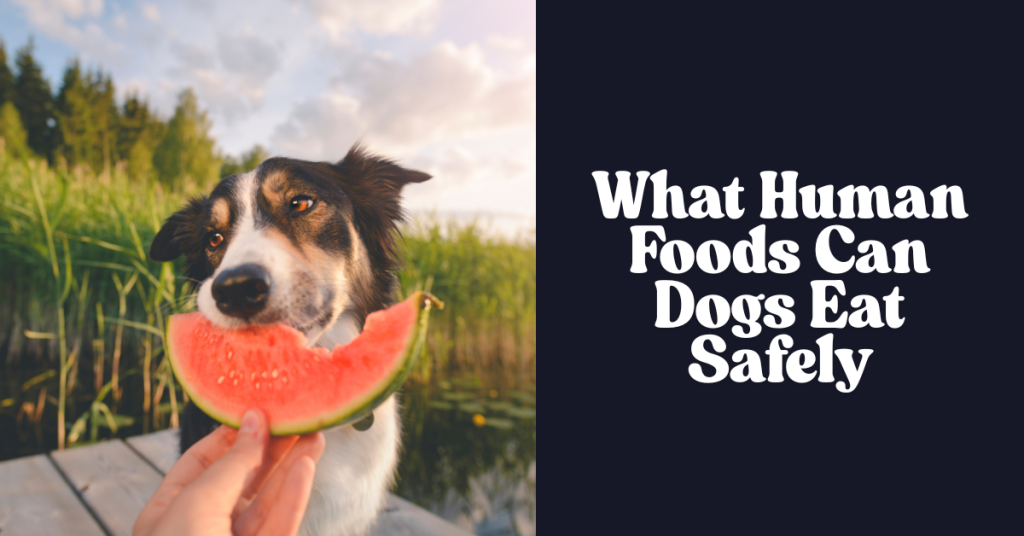Dogs can safely eat plain cooked chicken, turkey, beef, and salmon for lean protein. They can enjoy fruits like apples, blueberries, bananas, and watermelon, and vegetables like carrots, green beans, and pumpkin. Plain rice, oatmeal, and peanut butter (xylitol-free) are also safe. Avoid onions, garlic, chocolate, grapes, and raisins, which are toxic to dogs.
How To Decide If A Human Food Is Dog-Safe
Sharing food with dogs shouldn’t be guesswork. I use a simple five-step filter before offering anything new:
- Read the label like a hawk. Check for xylitol, onion/garlic powder, alcohol, caffeine, chocolate, grapes/raisins, macadamia nuts, or artificial sweeteners. These are red flags.
- Evaluate the macronutrients. Favor lean protein, low-fat dairy, whole grains, and fiber-rich fruits/veggies. Watch added salt, sugar, and oils.
- Consider the dog’s size, age, and health. Puppies, seniors, and dogs with pancreatitis, kidney disease, diabetes, or food allergies need stricter rules.
- Start small and observe. Introduce new foods in teaspoon-sized amounts, then wait 24 hours to watch for digestive upset.
- Prepare it simply. Offer foods plain, without sauces, butter, or spices. Cook meats thoroughly and remove bones.
Personal note: Early in my career, I mistakenly offered a tiny bite of onion-laden stew to a foster dog—he was fine, but it taught me to check ingredients obsessively. That habit has prevented countless mishaps since.
Dog-Safe Fruits And Vegetables
Fruits and veggies can add hydration, fiber, vitamins, and low-calorie variety.
Fruits Most Dogs Can Enjoy
– Apples without seeds and core. They offer fiber and vitamin C. Slice thinly to prevent choking.
– Blueberries and strawberries in small amounts. They provide antioxidants and low sugar per bite.
– Bananas sparingly. A potassium boost, but higher in sugar; offer a few coins of banana, not half the fruit.
– Watermelon without seeds or rind. Hydrating and refreshing; perfect for hot days.
– Cantaloupe and pears in bite-size pieces with seeds removed. Keep portions modest.
Vegetables That Work Well
– Carrots raw or lightly steamed. Crunchy, low-calorie training bites that help satisfy chewing urges.
– Green beans plain and cooked or raw. Many weight-loss plans use them to replace part of the kibble volume.
– Cucumbers and zucchini. Hydrating, low-calorie, and easy to digest when sliced thin.
– Pumpkin plain and unsweetened. A spoonful can help regulate stool consistency thanks to soluble fiber.
– Broccoli and cauliflower in small, cooked amounts. Too much can cause gas; keep portions tiny.
– Spinach and kale lightly cooked. Nutrient-dense, but rotate to avoid oxalate overload in sensitive dogs.
Evidence-backed note: Veterinary nutrition guidelines and toxicology reports consistently list grapes/raisins, onions/garlic, and xylitol as toxic, while items above appear in safe lists when prepared and portioned properly. Always remove seeds, pits, and tough rinds.
Proteins And Dairy: What’s Acceptable
Protein is crucial for muscle, immune function, and repair. The key is choosing lean options and simple preparation.
Dog-Friendly Proteins
– Chicken and turkey skinless and boneless. Boiled, baked, or air-fried without seasoning.
– Beef and pork in lean cuts. Trim fat and cook thoroughly. Avoid cured meats due to salt and nitrates.
– Salmon and sardines packed in water. Offer cooked salmon and deboned; sardines should be low-sodium.
– Eggs cooked. Scrambled in a dry pan or hard-boiled. Raw eggs carry bacterial risk.
– Plain tofu in moderation. Some dogs tolerate it well; introduce slowly to assess gas or sensitivity.
What About Dairy?
– Plain yogurt and kefir without sweeteners. Small dollops can support gut health if your dog tolerates lactose.
– Cottage cheese low-fat. Soft on the stomach for many dogs recovering from minor GI upset.
– Cheese as a high-value training treat. Use small cubes and avoid rich, aged cheeses to limit salt and fat.
Personal insight: I rely on a “one-ingredient rule” for proteins during training sessions—plain chicken breast or a small piece of hard-boiled egg. Dogs stay focused, and I control fat and salt.
Grains And Carbs That Are Generally Safe
Carbohydrates can provide energy and fiber, especially helpful for active dogs or those needing weight management strategies.
- White rice and plain pasta in small servings. Useful during bland-diet periods for mild stomach upset.
- Oatmeal plain and cooked. Adds soluble fiber; great for dogs with occasional loose stools.
- Quinoa rinsed and cooked. Higher in protein than many grains; serve in small amounts.
- Whole-grain bread plain. A nibble is fine, but avoid seeds, nuts on crusts, and any raisin breads.
- Sweet potatoes and regular potatoes cooked and plain. Avoid skins for sensitive dogs and never feed green potatoes.
Tip: For weight control, I mix a portion of green beans and a spoon of pumpkin with a small serving of rice to increase fullness without overfeeding calories.
Healthy Fats, Oils, And Crunchy Treats
Dogs need fats for energy, coat quality, and vitamin absorption, but portion control prevents weight gain and pancreatitis risk.
- Olive oil or fish oil in tiny amounts. A few drops on meals can support skin and coat; check with your vet if your dog has pancreatitis.
- Peanut butter without xylitol. Use a thin smear inside a toy. Verify the label every time.
- Plain popcorn air-popped. No butter, no salt; pieces should be fully popped to avoid choking.
- Pumpkin seeds plain and unsalted, crushed. Offer sparingly for crunch and minerals.
Key takeaway: Even healthy fats should be measured. I use a 1/4 teaspoon measure for oils per 20–30 pounds of body weight, only a few times per week unless a vet recommends otherwise.
Foods Dogs Should Avoid Or That Require Caution
Keep this list on your fridge. These items are linked to toxicity or common ER visits in veterinary data.
Never Feed
– Grapes and raisins. Associated with acute kidney injury, even in small amounts.
– Chocolate and cocoa. Theobromine and caffeine can cause cardiac and neurologic signs; darker chocolate is more dangerous.
– Onions, garlic, leeks, chives. Can damage red blood cells and lead to anemia.
– Xylitol-sweetened products. Triggers rapid insulin release and potential liver failure.
– Alcohol and unbaked yeasted dough. Risk of ethanol poisoning and bloat.
– Macadamia nuts. Neurotoxicity has been reported even with small doses.
Use Extreme Caution
– High-fat foods like bacon, skins, butter, rich gravies. Risk of pancreatitis.
– Cooked bones. They can splinter and cause internal injury or obstruction.
– Salt-heavy snacks and cured meats. May cause sodium ion poisoning or worsen heart/kidney issues.
– Spicy foods and heavily seasoned leftovers. GI upset is common and sometimes severe.
– Large rawhide pieces or hard chews. Choking and obstruction risks; choose size-appropriate, digestible options.
If ingestion happens, note the amount and time, then call your veterinarian or an emergency poison helpline immediately. Early action saves lives.
Portions, Preparation, And Transition Tips
A little planning makes shared foods safe and beneficial.
- Follow the 90/10 rule. Keep 90% of calories from a complete dog diet and 10% or less from human-food treats.
- Size portions to your dog. For a 20–30 lb dog, start with 1–2 teaspoons of a new food. For giant breeds, 1–2 tablespoons.
- Prepare plainly. Boil, bake, steam, or air-fry without oil, salt, or spices. Remove bones, seeds, pits, and skins as needed.
- Use food as training currency. Tiny, soft pieces of lean protein work best and reduce overfeeding.
- Introduce slowly. Add one new food at a time, spaced a few days apart to identify sensitivities.
Anecdote: When I coached a client with an anxious rescue, we swapped biscuit treats for pea-sized chicken pieces during “relax on the mat” training. Focus improved, and we shaved 15% off daily calories by measuring exactly.
Special Cases: Puppies, Seniors, And Health Conditions
Some dogs need stricter rules and veterinary guidance.
- Puppies. Their diets must be balanced for growth. Use human foods sparingly and stick to lean proteins and simple carbs during training. Avoid heavy calcium extras.
- Seniors. Consider softer textures and smaller, more frequent portions. Watch sodium and phosphorus.
- Pancreatitis-prone dogs. Avoid high-fat foods completely; even a single fatty meal can trigger a flare.
- Kidney disease. Limit high-phosphorus foods like organ meats and some dairy; monitor protein and sodium.
- Diabetes. Prioritize low-glycemic options and consistent portions; avoid sugary fruits and starch overload.
- Food allergies or sensitivities. Trial new foods individually and consult a vet for elimination diets.
Reminder: Medical conditions change the rules. When I manage nutrition plans for seniors, I pre-approve treat lists with their vet so every bite aligns with lab results and meds.
How To Spot A Bad Reaction And What To Do
Act quickly if your dog shows warning signs after eating a new food.
- Mild GI upset. Brief soft stool or gas can be normal when introducing something new. Pause the new food and offer small, frequent meals.
- Concerning symptoms. Repeated vomiting, diarrhea lasting more than 24 hours, lethargy, trembling, pale gums, abdominal pain, or excessive thirst/urination warrant immediate vet care.
- Suspected toxin ingestion. Do not wait. Contact your veterinarian or an emergency poison line and provide the food type, amount, and time eaten.
Keep packaging or take a photo of ingredient labels; it helps veterinary teams act faster.
FAQ’s
Can Dogs Eat Peanut Butter?
Yes, if it is free of xylitol and low in salt and sugar. Offer a thin smear as an occasional treat, not a daily staple, and adjust calories elsewhere.
Are Eggs Good For Dogs?
Cooked eggs are a great protein source for most dogs. Serve scrambled without oil or hard-boiled, in small amounts. Avoid raw due to bacterial risk.
Which Fruits Are Safest?
Apples (no seeds), blueberries, strawberries, bananas (small portions), and seedless watermelon are commonly well-tolerated. Always introduce slowly.
Can Dogs Have Cheese?
In moderation. Many dogs tolerate small amounts of low-fat cheese, but some are lactose-sensitive. Use as a high-value training reward and watch calories.
Is Rice Okay For Upset Stomachs?
Plain white rice can help in a short-term bland diet. Pair with lean boiled chicken and reintroduce the regular diet gradually once stools normalize.
What Vegetables Work As Low-Calorie Treats?
Carrot sticks, green beans, cucumber slices, and steamed zucchini are popular, crunchy, and low in calories.
What Human Foods Are Toxic To Dogs?
Grapes/raisins, chocolate, onions/garlic, xylitol, macadamia nuts, alcohol, and unbaked yeasted dough are among the most dangerous and should be avoided completely.
Conclusion
Sharing food with your dog can be safe and healthy when you focus on simple, whole ingredients, smart portions, and careful preparation. Prioritize lean proteins, fiber-rich fruits and veggies, and avoid known toxins and high-fat traps. Start small, observe closely, and personalize choices to your dog’s age and health needs. Ready to create a vet-approved treat plan?
Try one new safe food this week, measure it carefully, and note how your dog responds. Want more evidence-based tips? Subscribe, leave a comment with your dog’s favorite safe snack, or explore our upcoming guides on homemade toppers and balanced treat rotations.
I’ve loved dogs all my life and have cared for many different breeds over the years. Here, I share simple tips, stories, and helpful advice for all dog lovers. Whether you’re a new pet parent or a lifelong dog fan, you’ll find something useful and fun on my site.


